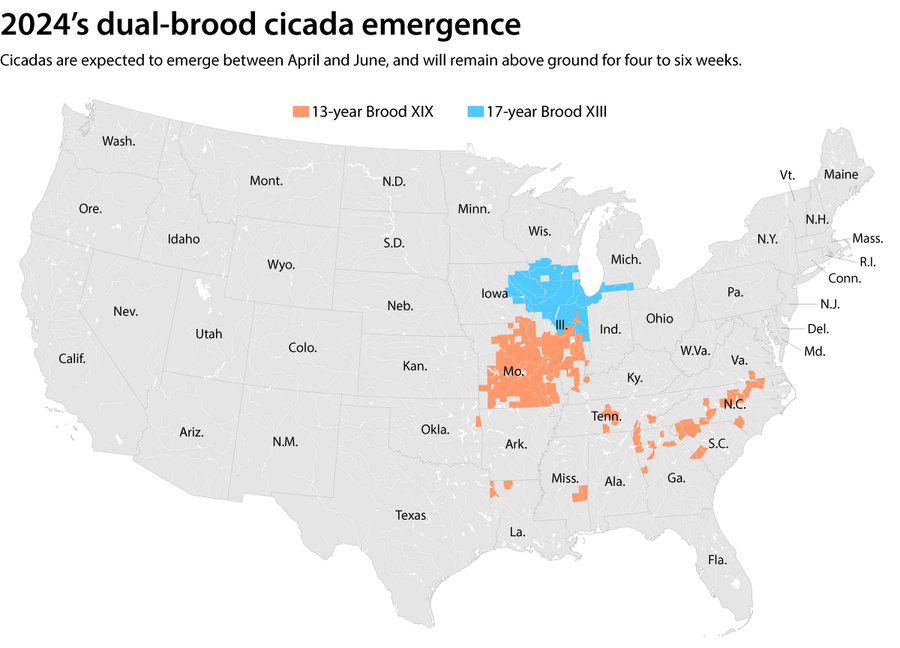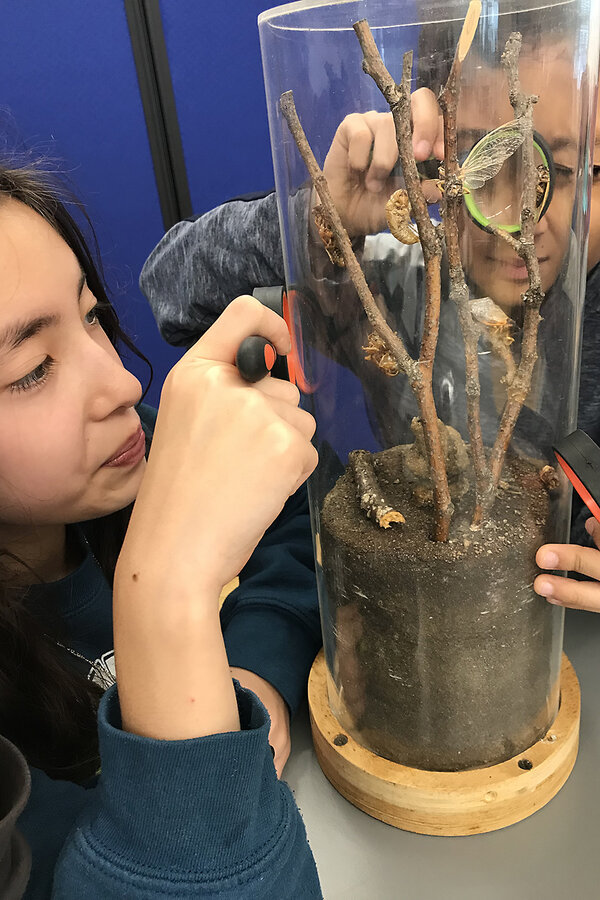Cicadas are out in the trillions and citizen scientists are rejoicing
Loading...
This spring, the once-in-221-years appearance of two cicada groups means swaths of the U.S. South and Midwest will be blanketed in the insects. For thousands of Americans, young and old, the emergence is offering a unique opportunity to engage their curiosity, lean into a sense of wonder, and get hands-on experiences learning about insect ecology.
“Periodical cicadas are the gateway drug to natural history,” says Gene Kritsky, an entomologist and professor emeritus at Mount St. Joseph University in Cincinnati. An app he created, Cicada Safari, lets users submit geotagged cicada pictures, contributing to a live, crowdsourced map.
Why We Wrote This
A story focused onThe rare emergence of two specific periodical cicada broods this year (which hasn’t happened since Thomas Jefferson was president) is inspiring some people to dive deeper into citizen science.
Steve Deacon, of Portland, Oregon, is leading a seven-person family trip to show his children and grandchildren the cicadas in central Illinois.
Lake County Forest Preserves in Illinois opened a museum exhibit celebrating cicadas, and is sponsoring a CicadaFest.
“The feeling used to be, ‘I want to stay away from the preserves during this time. I don’t want anything to do with cicadas,’” says Alyssa Firkus, director of education for the organization. “That has shifted, and it’s now, like, ‘I cannot wait to hear them come out. I want to see them.’”
As Randy Emmitt navigates a wooded lot, he notices a couple of things: patches of sunlight coming through the trees, and a near-inability to make out any sound other than a persistent screeching.
It doesn’t take long for him to duck inside his van, out of necessity.
“The cicadas are so loud,” he tells the Monitor over the phone from Hillsborough, North Carolina. “I can’t hear you.”
Why We Wrote This
A story focused onThe rare emergence of two specific periodical cicada broods this year (which hasn’t happened since Thomas Jefferson was president) is inspiring some people to dive deeper into citizen science.
You can’t walk around without feeling like they’re practically on top of you, he says.
But the swarms and piercing screams enveloping much of the Tar Heel State haven’t stopped Mr. Emmitt from doing what he loves – venturing out to track the insects down. Over the past couple weeks, he estimates he’s traveled to seven or eight counties to identify and photograph them, as well as the animals that have come out for a feeding frenzy.
Mr. Emmitt is a handyman and proud citizen scientist, with a particular affinity for observing butterflies, dragonflies – and, this season only, periodical cicadas. Annual cicadas emerge each summer, but their periodical counterparts grow underground much longer. They come up for four-to-six-week mating stints every 13 or 17 years, depending on their life cycle.
This spring, the once-in-221-years simultaneous appearance of two groups, Broods XIII and XIX, means swaths of the South and Midwest will be blanketed in cicadas. For Mr. Emmitt and thousands of Americans, young and old, the emergence is offering a unique opportunity to engage their curiosity, lean into a sense of wonder, and get hands-on experiences learning about insect ecology.
Citizen science, a movement that invites scientists to bring members of the public into their research, seems tailor-made for the cicada phenomenon. But it’s far from the concept’s only application. Organizations like NASA and the national parks are also inviting volunteers to participate in studies. The ventures are a powerful source of data and a chance to give people a taste of real-world experimentation.
“Periodical cicadas are the gateway drug to natural history,” says Gene Kritsky, an entomologist and professor emeritus at Mount St. Joseph University in Cincinnati. An app he created, Cicada Safari, offers information about the cicada emergence. Users can collect their own geotagged cicada pictures and contribute to a crowdsourced map about where the insects are appearing.
Three years ago, when one of the largest broods of periodical cicadas emerged across a swath of the eastern U.S., users sent in more than half a million photos. Professor Kritsky hopes some of the youth who use the app will be fascinated enough to look toward a science career.
Competitive cicada tracking
There will be plenty of opportunities for that inspiration to strike. The red-eyed insects, just longer than a quarter and boasting 3-inch wingspans, began surfacing late April in parts of the Southeast. They’ve now made appearances from Georgia to Missouri, according to Cicada Safari contributors. By next month, something on the order of a trillion periodical cicadas will have made their way above ground.
Ken Kaup was one of Cicada Safari’s newcomers this year. As the insects began popping up in his corner of southern Virginia, he snapped photos for his son, who recommended the app. He kept snapping photos out of curiosity and to help with the project. Soon, another reason developed: Cicada Safari features a leaderboard. The more verified pictures and videos users upload, the higher their scores rise.
Recently, Mr. Kaup was sitting in fourth place, with 810 photos and a single video to his name.
“Do I want to get to the top of the board? You know, initially, I thought, no way,” he says. “But now, yeah, I’ll bite.”
The cicadas are changing
When the observations make it back to Professor Kritsky, he uses them to sharpen the accuracy of his data on where the broods live – and where they don’t any longer. The insects sometimes naturally shift locations over the years. But their movements also tell a story about human impacts on the ecosystem.
In 2021, Dr. Kritsky says, the numbers of Brood X cicadas emerging in northern Indiana proved “much, much smaller than they were 150 years ago.” Deforestation, both for urban development and agriculture, are prime explanations.
“Cicadas need trees to reproduce and survive,” he says. “That’s how they live.”
P.J. Liesch, who goes by “Wisconsin’s Bug Guy” in public appearances, spent months tracking down evidence of the Badger State’s cicada sightings over hundreds of years. The director of the University of Wisconsin-Madison’s Insect Diagnostic Lab, Mr. Liesch says community science projects like Cicada Safari help researchers identify contemporary habitats. But historical data is harder to come by.
“It was fun,” he says. “I spent a lot of hours just searching through old newspaper records. I found some notes in the literature for Wisconsin from about the 1850s – so just a few years after statehood.”
Mr. Liesch is looking forward to the periodical cicadas’ emergence in his neck of the woods for a nonprofessional reason. Wisconsin’s Bug Guy has a gap in his bug bucket list.
“I have actually not seen these yet with my own eyes,” he admits. “I missed them in 2007, that’s the last time they were out here … I missed them in 1990, when I was a young kid, so this is going to be the first time I get to see and experience this amazing natural phenomenon.”
Chasing cicadas with custom T-shirts and museum exhibits
Some people are going farther than others to get that first interaction. Steve Deacon, of Portland, Oregon, is leading a seven-person family trip to show his children and grandchildren the cicadas in central Illinois, where some hope Broods XIII and XIX may overlap. He mocked up custom “Cicada Cascade” T-shirts that feature the next year both broods will emerge: 2245.
“It’s a whimsical trip,” Mr. Deacon says. But he’s done his research, and he’s eager to experience the notorious screeching in person.
“The talk about the noise is interesting, isn’t it?” he adds. “It can get up to over 100 decibels, like a rock band.”
For others, this moment is an opportunity to channel people’s enthusiasm for the cicadas into learning opportunities. Alyssa Firkus, director of education for the Lake County Forest Preserves in Illinois, says this season is an all-hands-on-deck one.
“People want to learn more about this,” she says. “The feeling used to be, ‘I want to stay away from the preserves during this time. I don’t want anything to do with cicadas.’ That has shifted, and it’s now, like, ‘I cannot wait to hear them come out. I want to see them.’”
The county just opened a museum exhibit celebrating cicadas’ historical significance and exploring their life cycles. It’s hosting a CicadaFest in early June, featuring guided tours through the forest to get up close and personal with the insects. And it’s sending educators into schools throughout the area to help students understand what’s happening and offer some ways to get involved.
One of those ways is by gathering cicada photos – and if that proves enjoyable, Ms. Firkus says there are plenty of other opportunities for Lake County’s young adults to participate in citizen science, like tracking the endangered rusty patched bumblebee or keeping an eye on local vegetation.
“When you’re part of something, you care about it and you’re invested in it,” she says. “One of the big benefits of community science is giving people that ability to connect with it in a deeper way, and feel like they’re part of a solution.”












